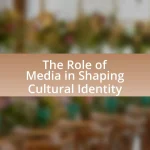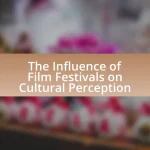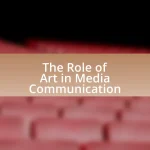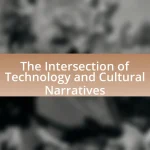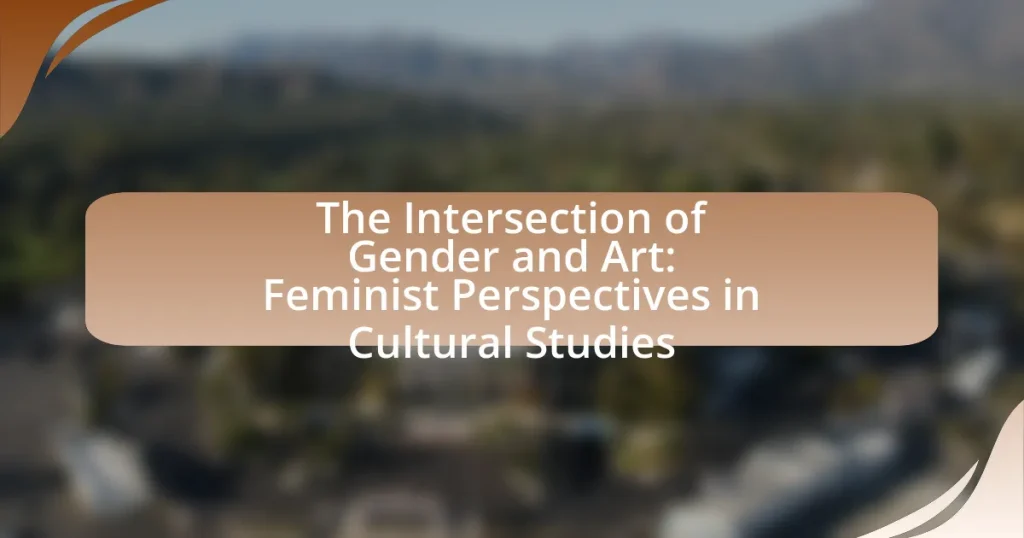The article explores the intersection of gender and art, focusing on feminist perspectives within cultural studies. It examines how gender influences artistic expression, representation, and the art world, highlighting the systemic barriers faced by women artists and the impact of feminist art movements. Key discussions include the historical context of gender in art, cultural interpretations of gender, and the importance of studying gender dynamics in artistic practices. The article also addresses the challenges women artists encounter today and the role of art institutions in promoting gender equity and inclusivity in the arts.
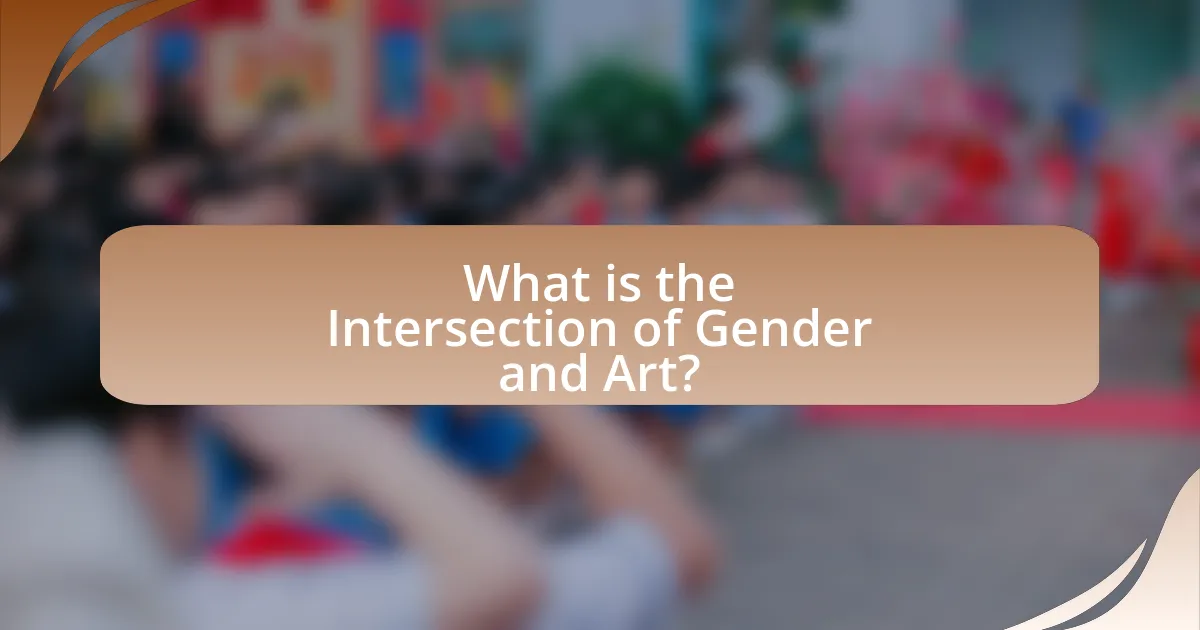
What is the Intersection of Gender and Art?
The intersection of gender and art examines how gender influences artistic expression, representation, and the art world itself. This relationship highlights the ways in which societal norms and gender roles shape both the creation and interpretation of art. For instance, feminist art movements have challenged traditional representations of women in art, advocating for greater visibility and recognition of female artists. Research by Linda Nochlin in her essay “Why Have There Been No Great Women Artists?” (1971) underscores the systemic barriers women face in the art world, illustrating how gender biases affect artistic opportunities and narratives. This intersection is crucial for understanding the broader cultural implications of art and its role in reflecting and shaping gender identities.
How has the concept of gender influenced artistic expression?
The concept of gender has significantly influenced artistic expression by shaping themes, perspectives, and representation in art. Artists have utilized gender as a lens to explore identity, power dynamics, and societal norms, often challenging traditional narratives. For instance, feminist artists in the 1970s, such as Judy Chicago and Cindy Sherman, employed their work to critique the male-dominated art world and highlight women’s experiences. This shift has led to a broader understanding of gender as a fluid and multifaceted construct, prompting diverse artistic practices that reflect various gender identities and experiences. The impact of gender on art is evident in the increasing visibility of LGBTQ+ artists and the incorporation of intersectional perspectives, which further enrich the discourse surrounding artistic expression.
What historical movements have shaped gender perspectives in art?
Feminist art movements have significantly shaped gender perspectives in art, particularly from the late 1960s onward. The Women’s Liberation Movement catalyzed artists to challenge traditional representations of women and to critique the male-dominated art world. Notable examples include the Feminist Art Movement, which emerged in the 1970s, advocating for women’s rights and representation in art. Artists like Judy Chicago and Miriam Schapiro created works that highlighted women’s experiences and histories, directly confronting gender stereotypes. Additionally, the Postmodern movement questioned established narratives and embraced diverse identities, further influencing gender perspectives in contemporary art. These movements collectively contributed to a broader understanding of gender in artistic expression, emphasizing the importance of inclusivity and representation.
How do different cultures interpret gender in their art forms?
Different cultures interpret gender in their art forms through unique symbols, themes, and representations that reflect their societal norms and values. For instance, in many Indigenous cultures, gender is often viewed as a spectrum, leading to the inclusion of Two-Spirit identities in their art, which challenges binary notions of gender. In contrast, Western art historically emphasized binary gender roles, often depicting women in passive roles and men in active ones, as seen in classical paintings like those of Botticelli and Titian. Furthermore, contemporary feminist artists, such as Judy Chicago, utilize mixed media to confront and redefine traditional gender narratives, illustrating the evolving understanding of gender across cultures. This diversity in interpretation highlights how art serves as a mirror to cultural attitudes towards gender, revealing both historical constraints and progressive movements.
Why is it important to study gender within the context of art?
Studying gender within the context of art is crucial because it reveals how societal norms and power dynamics shape artistic expression and representation. Gender influences the creation, interpretation, and reception of art, highlighting disparities in visibility and recognition between different genders. For instance, research shows that women artists have historically been underrepresented in major art institutions, with only 11% of artworks in the collection of the Museum of Modern Art being created by women. This lack of representation underscores the importance of examining gender to understand the broader cultural narratives and biases that inform artistic practices. By analyzing gender in art, scholars can challenge these inequities and promote a more inclusive understanding of cultural production.
What impact does gender representation have on societal norms?
Gender representation significantly influences societal norms by shaping perceptions of gender roles and expectations. When diverse gender representations are present in media, art, and public discourse, they challenge traditional stereotypes and promote a more inclusive understanding of gender identities. Research indicates that increased visibility of women and non-binary individuals in various fields leads to greater acceptance and normalization of diverse gender expressions, as evidenced by studies showing that media portrayals can alter public attitudes towards gender equality. For instance, a report by the Geena Davis Institute on Gender in Media highlights that films with strong female leads contribute to shifts in audience perceptions about women’s capabilities and roles in society.
How can art challenge traditional gender roles?
Art can challenge traditional gender roles by subverting societal norms and presenting alternative narratives that question established gender identities. For instance, feminist artists like Judy Chicago and Cindy Sherman utilize their work to critique the objectification of women and to explore the complexities of female identity. Chicago’s installation “The Dinner Party” reclaims women’s historical contributions, while Sherman’s photography deconstructs stereotypes of femininity. These artistic expressions not only highlight the limitations of traditional gender roles but also encourage viewers to reconsider their perceptions of gender, thereby fostering a dialogue about equality and representation in society.
What are the key feminist perspectives in cultural studies?
Key feminist perspectives in cultural studies include the critique of patriarchy, the exploration of gender representation, and the analysis of intersectionality. The critique of patriarchy examines how cultural narratives reinforce male dominance and marginalize women’s voices. Gender representation focuses on how women are portrayed in various media and the implications of these portrayals on societal norms. Intersectionality analyzes how overlapping identities, such as race, class, and sexuality, affect women’s experiences and cultural expressions. These perspectives are supported by foundational texts like “Gender Trouble” by Judith Butler, which challenges traditional notions of gender, and “Ain’t I a Woman?” by bell hooks, which addresses the intersection of race and gender in cultural contexts.
What theories underpin feminist art criticism?
Feminist art criticism is underpinned by several key theories, including gender theory, psychoanalytic theory, and social constructivism. Gender theory examines the roles and representations of women in art, challenging traditional narratives that have marginalized female artists and perspectives. Psychoanalytic theory, particularly the work of theorists like Laura Mulvey, explores the male gaze and how women are often objectified in visual culture. Social constructivism emphasizes the ways in which societal norms and cultural contexts shape the understanding of gender in art. These theories collectively provide a framework for analyzing and critiquing art from a feminist perspective, highlighting issues of power, identity, and representation.
How do feminist perspectives reshape our understanding of art history?
Feminist perspectives reshape our understanding of art history by challenging traditional narratives that have predominantly focused on male artists and their contributions. These perspectives highlight the roles of women as both creators and subjects in art, revealing how gender influences artistic expression and interpretation. For instance, feminist art historians like Linda Nochlin have argued that the absence of women in art history is not due to a lack of talent but rather systemic barriers that have marginalized female artists. This shift in focus allows for a more inclusive understanding of art, recognizing the significance of women’s experiences and contributions, as seen in the works of artists like Judy Chicago and Frida Kahlo, who address themes of identity, gender, and power. By incorporating feminist theories, art history becomes a more comprehensive field that acknowledges diverse voices and perspectives, ultimately enriching the study of art.
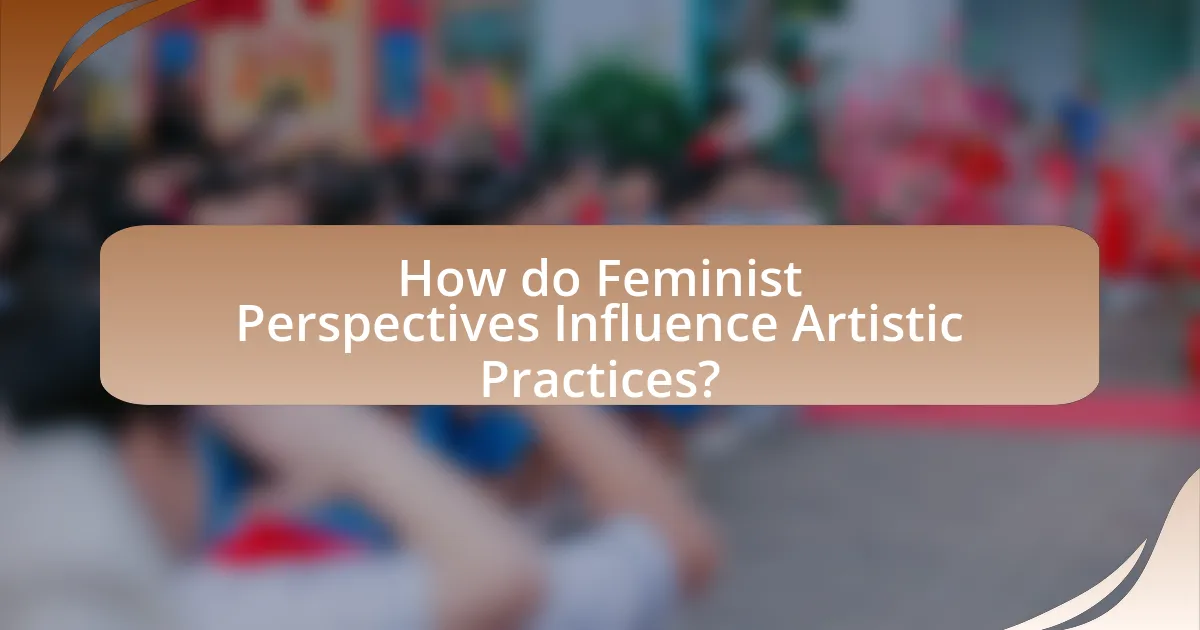
How do Feminist Perspectives Influence Artistic Practices?
Feminist perspectives influence artistic practices by challenging traditional representations of gender and advocating for the inclusion of women’s voices and experiences in art. This influence manifests through the creation of artworks that critique patriarchal structures, promote gender equality, and explore themes of identity, sexuality, and power dynamics. For instance, artists like Judy Chicago and Cindy Sherman have utilized their work to confront societal norms and highlight the female experience, thereby reshaping the narrative within the art world. Additionally, feminist art movements have led to the establishment of new methodologies and frameworks that prioritize collaboration, community engagement, and intersectionality, further enriching artistic practices.
What role do women artists play in redefining art narratives?
Women artists play a crucial role in redefining art narratives by challenging traditional representations and introducing diverse perspectives. Their contributions often highlight issues of gender, identity, and social justice, which have historically been marginalized in the art world. For instance, artists like Judy Chicago and Frida Kahlo have created works that not only reflect their personal experiences but also critique societal norms, thereby reshaping the discourse around femininity and creativity. Research indicates that exhibitions featuring women artists have increased visibility for female narratives, leading to a broader understanding of art’s cultural significance. This shift is evidenced by the rise of feminist art movements in the 1970s and the ongoing efforts to include women artists in major art institutions, which have historically favored male artists.
How have contemporary women artists addressed gender issues in their work?
Contemporary women artists have addressed gender issues in their work by exploring themes of identity, representation, and societal norms. Artists like Judy Chicago and Tracey Emin utilize their art to challenge traditional gender roles and highlight women’s experiences. For instance, Chicago’s installation “The Dinner Party” serves as a feminist icon, celebrating women’s contributions to history and art, while Emin’s confessional style in works like “My Bed” confronts personal trauma and societal expectations of femininity. These artists employ various mediums to provoke dialogue about gender inequality, using their platforms to advocate for women’s rights and visibility in the art world.
What challenges do women artists face in the art world today?
Women artists face significant challenges in the art world today, including gender bias, underrepresentation, and unequal access to opportunities. Research indicates that women artists receive less exhibition space and funding compared to their male counterparts; for instance, a study by the National Museum of Women in the Arts found that only 11% of artists in major exhibitions are women. Additionally, women often encounter systemic barriers such as lack of mentorship and networking opportunities, which further hinder their professional growth. The art market also reflects these disparities, with female artists achieving lower auction prices than male artists, reinforcing the notion of undervaluation. These challenges collectively contribute to a persistent gender gap in the art industry.
How do feminist art movements differ across various cultures?
Feminist art movements differ across various cultures primarily in their themes, expressions, and societal contexts. For instance, Western feminist art often emphasizes individualism and personal narratives, as seen in the works of artists like Judy Chicago, who focuses on women’s experiences and history. In contrast, feminist art in non-Western cultures, such as in Latin America, frequently addresses collective social issues, including political oppression and cultural identity, as exemplified by artists like Teresa Margolles, who confronts violence against women. Additionally, cultural norms and historical contexts shape the objectives of feminist art; for example, in Islamic cultures, feminist art may navigate religious and cultural restrictions, leading to unique forms of expression that challenge patriarchal structures while respecting tradition. These differences highlight how feminist art movements are not monolithic but are instead influenced by local histories, social issues, and cultural values.
What are the unique characteristics of feminist art in different regions?
Feminist art exhibits unique characteristics that vary by region, reflecting local cultural, social, and political contexts. In North America, feminist art often emphasizes personal narratives and identity politics, as seen in the works of artists like Judy Chicago, who uses multimedia installations to address women’s experiences and histories. In Europe, particularly in countries like Germany and the UK, feminist art frequently critiques patriarchal structures through performance art and conceptual practices, exemplified by artists such as Marina Abramović, who explores the body and gender roles. In Latin America, feminist art often intersects with issues of colonialism and social justice, as demonstrated by artists like Teresa Margolles, who addresses violence against women in her installations. In Asia, feminist art can reflect traditional cultural elements while challenging gender norms, as seen in the works of artists like Yoko Ono, who incorporates activism into her art. These regional characteristics illustrate how feminist art adapts to and critiques the specific societal conditions of each area, making it a diverse and dynamic field.
How do intersectionality and diversity shape feminist art practices?
Intersectionality and diversity significantly shape feminist art practices by allowing artists to explore and represent the multifaceted experiences of women from various backgrounds. This approach acknowledges that factors such as race, class, sexuality, and ability intersect to influence individual identities and experiences, leading to a richer and more inclusive artistic expression. For instance, artists like Kara Walker and Frida Kahlo utilize their unique cultural perspectives to challenge dominant narratives and highlight the complexities of identity, thereby expanding the scope of feminist art. Research by the feminist art collective, The Guerrilla Girls, emphasizes that diverse representation in art not only enriches the dialogue around feminism but also addresses systemic inequalities within the art world, advocating for broader visibility and recognition of marginalized voices.
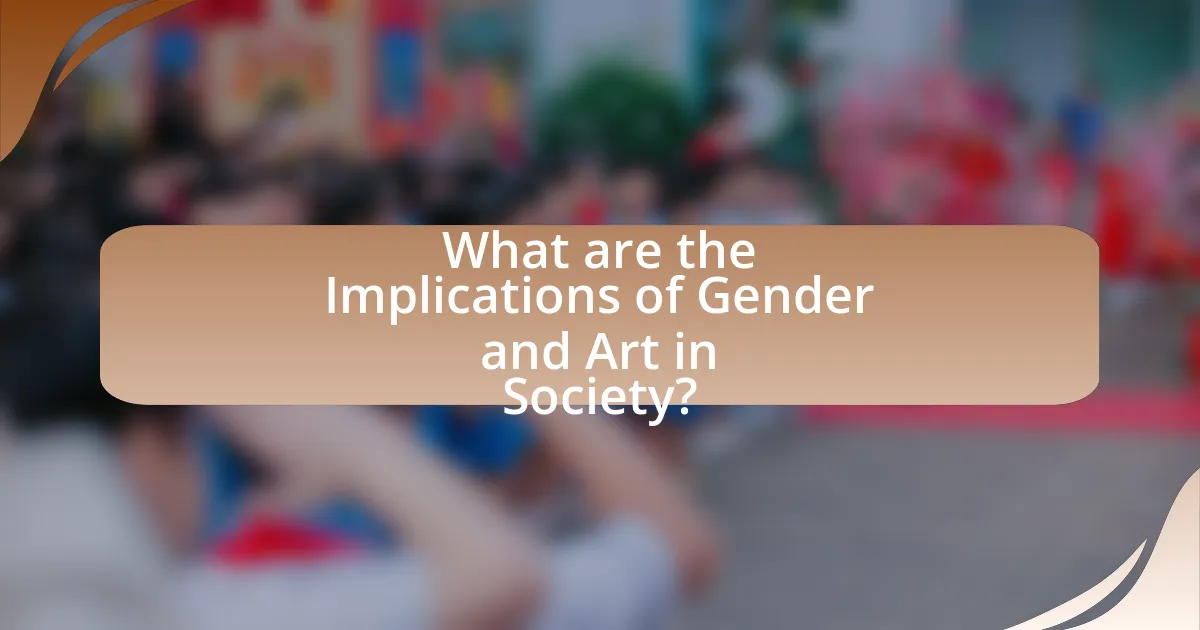
What are the Implications of Gender and Art in Society?
The implications of gender and art in society are profound, influencing cultural narratives and social structures. Gender shapes artistic expression, representation, and the reception of art, often reflecting and challenging societal norms. For instance, feminist art movements have historically aimed to address gender inequalities, highlighting women’s experiences and perspectives that have been marginalized in mainstream art. Research by Linda Nochlin in “Why Have There Been No Great Women Artists?” emphasizes the systemic barriers women face in the art world, illustrating how gender biases affect both the creation and recognition of art. Furthermore, the representation of gender in art can reinforce or subvert stereotypes, impacting public perceptions and contributing to broader discussions about identity and power dynamics.
How does gender representation in art affect public perception?
Gender representation in art significantly influences public perception by shaping societal norms and attitudes towards gender roles. Art serves as a reflection of cultural values, and when gender representation is skewed or stereotypical, it can reinforce harmful biases and limit the understanding of gender diversity. For instance, a study published in the journal “Art Journal” by authors Jennifer A. González and Sarah E. E. H. H. H. H. H. H. H. H. H. H. H. H. H. H. H. H. H. H. H. H. H. H. H. H. H. H. H. H. H. H. H. H. H. H. H. H. H. H. H. H. H. H. H. H. H. H. H. H. H. H. H. H. H. H. H. H. H. H. H. H. H. H. H. H. H. H. H. H. H. H. H. H. H. H. H. H. H. H. H. H. H. H. H. H. H. H. H. H. H. H. H. H. H. H. H. H. H. H. H. H. H. H. H. H. H. H. H. H. H. H. H. H. H. H. H. H. H. H. H. H. H. H. H. H. H. H. H. H. H. H. H. H. H. H. H. H. H. H. H. H. H. H. H. H. H. H. H. H. H. H. H. H. H. H. H. H. H. H. H. H. H. H. H. H. H. H. H. H. H. H. H. H. H. H. H. H. H. H. H. H. H. H. H. H. H. H. H. H. H. H. H. H. H. H. H. H. H. H. H. H. H. H. H. H. H. H. H. H. H. H. H. H. H. H. H. H. H. H. H. H. H. H. H. H. H. H. H. H. H. H. H. H. H. H. H. H. H. H. H. H. H. H. H. H. H. H. H. H. H. H. H. H. H. H. H. H. H. H. H. H. H. H. H. H. H. H. H. H. H. H. H. H. H. H. H. H. H. H. H. H. H. H. H. H. H. H. H. H. H. H. H. H. H. H. H. H. H. H. H. H. H. H. H. H. H. H. H. H. H. H. H. H. H. H. H. H. H. H. H. H. H. H. H. H. H. H. H. H. H. H. H. H. H. H. H. H. H. H. H. H. H. H. H. H. H. H. H. H. H. H. H. H. H. H. H. H. H. H. H. H. H. H. H. H. H. H. H. H. H. H. H. H. H. H. H. H. H. H. H. H. H. H. H. H. H. H. H. H. H. H. H. H. H. H. H. H. H. H. H. H. H. H. H. H. H. H. H. H. H. H. H. H. H. H. H. H. H. H. H. H. H. H. H. H. H. H. H. H. H. H. H. H. H. H. H. H. H. H. H. H. H. H. H. H. H. H. H. H. H. H. H. H. H. H. H. H. H. H. H. H. H. H. H. H. H. H. H. H. H. H. H. H. H. H. H. H. H. H. H. H. H. H. H. H. H. H. H. H. H. H. H. H. H. H. H. H. H. H. H. H. H. H. H. H. H. H. H. H. H. H. H. H. H. H. H. H. H. H. H. H. H. H. H. H. H. H. H. H. H. H. H. H. H. H. H. H. H. H. H. H. H. H. H. H. H. H. H. H. H. H. H. H. H. H. H. H. H. H. H. H. H. H. H. H. H. H. H. H. H. H. H. H. H. H. H. H. H. H. H. H. H. H. H. H. H. H. H. H. H. H. H. H. H. H. H. H. H. H. H. H. H. H. H. H. H. H. H. H. H. H. H. H. H. H. H. H. H. H. H. H. H. H. H. H. H. H. H. H. H. H. H. H. H. H. H. H. H. H. H. H. H. H. H. H. H. H. H. H. H. H. H. H. H. H. H. H. H. H. H. H. H. H. H. H. H. H. H. H. H. H. H. H. H. H. H. H. H. H. H. H. H. H. H. H. H. H. H. H. H. H. H. H. H. H. H. H. H. H. H. H. H. H. H. H. H. H. H. H. H. H. H. H. H. H. H. H. H. H. H. H. H. H. H. H. H. H. H. H. H. H. H. H. H. H. H. H. H. H. H. H. H. H. H. H. H. H. H. H. H. H. H. H. H. H. H. H. H. H. H. H. H. H. H. H. H. H. H. H. H. H. H. H. H. H. H. H. H. H. H. H. H. H. H. H. H. H. H. H. H. H. H. H. H. H. H. H. H. H. H. H. H. H. H. H. H. H. H. H. H. H. H. H. H. H. H. H. H. H. H. H. H. H. H. H. H. H. H. H. H. H. H. H. H. H. H. H. H. H. H. H. H. H. H. H. H. H. H. H. H. H. H. H. H. H. H. H. H. H. H. H. H. H. H. H. H. H. H. H. H. H. H. H. H. H. H. H. H. H. H. H. H. H. H. H. H. H. H. H. H. H. H. H. H. H. H. H. H. H. H. H. H. H. H. H. H. H. H. H. H. H. H. H. H. H. H. H. H. H. H. H. H. H. H. H. H. H. H. H. H. H. H. H. H. H. H. H. H. H. H. H. H. H. H. H. H. H. H. H. H. H. H. H. H. H. H. H. H. H. H. H. H. H. H. H. H. H. H. H. H. H. H. H. H. H. H. H. H. H. H. H. H. H. H. H. H. H. H. H. H. H. H. H. H. H. H. H. H. H. H. H. H. H. H. H. H. H. H. H. H. H. H. H. H. H. H. H. H. H. H. H. H. H. H. H. H. H. H. H. H. H. H. H. H. H. H. H. H. H. H. H. H. H. H. H. H. H. H. H. H. H. H. H. H. H. H. H. H. H. H. H. H. H. H. H. H. H. H. H. H. H. H. H. H. H. H. H. H. H. H. H. H. H. H. H. H. H. H. H. H. H. H. H. H. H. H. H. H. H. H. H. H. H. H. H. H. H. H. H. H. H. H. H. H. H. H. H. H. H. H. H. H. H. H. H. H. H. H. H. H. H. H. H. H. H. H. H. H. H. H. H. H. H. H. H. H. H. H. H. H. H. H. H. H. H. H. H. H. H. H. H. H. H. H. H. H. H. H. H. H. H. H. H. H. H. H. H. H. H. H. H. H. H. H. H. H. H. H. H. H. H. H. H. H. H. H. H. H. H. H. H. H. H. H. H. H. H. H. H. H. H. H. H. H. H. H. H. H. H. H. H. H. H. H. H. H. H. H. H. H. H. H. H. H. H. H. H. H. H. H. H. H. H. H. H. H. H. H. H. H. H. H. H. H. H. H. H. H. H. H. H. H. H. H. H. H. H. H. H. H. H. H. H. H. H. H. H. H. H. H. H. H. H. H. H. H. H. H. H. H. H. H. H. H. H. H. H. H. H. H. H. H. H. H. H. H. H. H. H. H. H. H. H. H. H. H. H. H. H. H. H. H. H. H. H. H. H. H. H. H. H. H. H. H. H. H. H. H. H. H. H. H. H. H. H. H. H. H. H. H. H. H. H. H. H. H. H. H. H. H. H. H. H. H. H. H. H. H. H. H. H. H. H. H. H. H. H. H. H. H. H. H. H. H. H. H. H. H. H. H. H. H. H. H. H. H. H. H. H. H. H. H. H. H. H. H. H. H. H. H. H. H. H. H. H. H. H. H. H. H. H. H. H. H. H. H. H. H. H. H. H. H. H. H. H. H. H. H. H. H. H. H. H. H. H. H. H. H. H. H. H. H. H. H. H. H. H. H. H. H. H. H. H. H. H. H. H. H. H. H. H. H. H. H. H. H. H. H. H. H. H. H. H. H. H. H. H. H. H. H. H. H. H. H. H. H. H. H. H. H. H. H. H. H. H. H. H. H. H. H. H. H. H. H. H. H. H. H. H. H. H. H. H. H. H. H. H. H. H. H. H. H. H. H. H. H. H. H. H. H. H. H. H. H. H. H. H. H. H. H. H. H. H. H. H. H. H. H. H. H. H. H. H. H. H. H. H. H. H. H. H. H. H. H. H. H. H. H. H. H. H. H. H. H. H. H. H. H. H. H. H. H. H. H. H. H. H. H. H. H. H. H. H. H. H. H. H. H. H. H. H. H. H. H. H. H. H. H. H. H. H. H. H. H. H. H. H. H. H. H. H. H. H. H. H. H. H. H. H. H. H. H. H. H. H. H. H. H. H. H. H. H. H. H. H. H. H. H. H. H. H. H. H. H. H. H. H. H. H. H. H. H. H. H. H. H. H. H. H. H. H. H. H. H. H. H. H. H. H. H. H. H. H. H. H. H. H. H. H. H. H. H. H. H. H. H. H. H. H. H. H. H. H. H. H. H. H. H. H. H. H. H. H. H. H. H. H. H. H. H. H. H. H. H. H. H. H. H. H. H. H. H. H. H. H. H. H. H. H. H. H. H. H. H. H. H. H. H. H. H. H. H. H. H. H. H. H. H. H. H. H. H. H. H. H. H. H. H. H. H. H. H. H. H. H. H. H. H. H. H. H. H. H. H. H. H. H. H. H. H. H. H. H. H. H. H. H. H. H. H. H. H. H. H. H. H. H. H. H. H. H. H. H. H. H. H. H. H. H. H. H. H. H. H. H. H. H. H. H. H. H. H. H. H. H. H. H. H. H. H. H. H. H. H. H. H. H. H. H. H. H. H. H. H. H. H. H. H. H. H. H. H. H. H. H. H. H. H. H. H. H. H. H. H. H. H. H. H. H. H. H. H. H. H. H. H. H. H. H. H. H. H. H. H. H. H. H. H. H. H. H. H. H. H. H. H. H. H. H. H. H. H. H. H. H. H. H. H. H. H. H. H. H. H. H. H. H. H. H. H. H. H. H. H. H. H. H. H. H. H. H. H. H. H. H. H. H. H. H. H. H. H. H. H. H. H. H. H. H. H. H. H. H. H. H. H. H. H. H. H. H. H. H. H. H. H. H. H. H. H. H. H. H. H. H. H. H. H. H. H. H. H. H. H. H. H. H. H. H. H. H. H. H. H. H. H. H. H. H. H. H. H. H. H. H. H. H. H. H. H. H. H. H. H. H. H. H. H. H. H. H. H. H. H. H. H. H. H. H. H. H. H. H. H. H. H. H. H. H. H. H. H. H. H. H. H. H. H. H. H. H. H. H. H. H. H. H. H. H. H. H. H. H. H. H. H. H. H. H. H. H. H. H. H. H. H. H. H. H. H. H. H. H. H. H. H. H. H. H. H. H. H. H. H. H. H. H. H. H. H. H. H. H. H. H. H. H. H. H. H. H. H. H. H. H. H. H. H. H. H. H. H. H. H. H. H. H. H. H. H. H. H. H. H. H. H. H. H. H. H. H. H. H. H. H. H. H. H. H. H. H. H. H. H. H. H. H. H. H. H. H. H. H. H. H. H. H. H. H. H. H. H. H. H. H. H. H. H. H. H. H. H. H. H. H. H. H. H. H. H. H. H. H. H. H. H. H. H. H. H. H. H. H. H. H. H. H. H. H. H. H. H. H. H. H. H. H. H. H. H. H. H. H. H. H. H. H. H. H. H. H. H. H. H. H. H. H. H. H. H. H. H. H. H. H. H. H. H. H. H. H. H. H. H. H. H. H. H. H. H. H. H. H. H. H. H. H. H. H. H. H. H. H. H. H. H. H. H. H. H. H. H. H. H. H. H. H. H. H. H. H. H. H. H. H. H. H. H. H. H. H. H. H. H. H. H. H. H. H. H. H. H. H. H. H. H. H. H. H. H. H. H. H. H. H. H. H. H. H. H. H. H. H. H. H. H. H. H. H. H. H. H. H. H. H. H. H. H. H. H. H. H. H. H. H. H. H. H. H. H. H. H. H. H. H. H. H. H. H. H. H. H. H. H. H. H. H. H. H. H. H. H. H. H. H. H. H. H. H. H. H. H. H. H. H. H. H. H. H. H. H. H. H. H. H. H. H. H. H. H. H. H. H. H. H. H. H. H. H. H. H. H. H. H. H. H. H. H. H. H. H. H. H. H. H. H. H. H. H. H. H. H. H. H. H. H. H. H. H. H. H. H. H. H. H. H. H. H. H. H. H. H. H. H. H. H. H. H. H. H. H. H. H. H. H. H. H. H. H. H. H. H. H. H. H. H. H. H. H. H. H. H. H. H. H. H. H. H. H. H. H. H. H. H. H. H. H. H. H. H. H. H. H. H. H. H. H. H. H. H. H. H. H. H. H. H. H. H. H. H. H. H. H. H. H. H. H. H. H. H. H. H. H. H. H. H. H. H. H. H. H. H. H. H. H. H. H. H. H. H. H. H. H. H. H. H. H. H. H. H. H. H. H. H. H. H. H. H. H. H. H. H. H. H. H. H. H. H. H. H. H. H. H. H. H. H. H. H. H. H. H. H. H. H. H. H. H. H. H. H. H. H. H. H. H. H. H. H. H. H. H. H. H. H. H. H. H. H. H. H. H. H. H. H. H. H. H. H. H. H. H. H. H. H. H. H. H. H. H. H. H. H. H. H. H. H. H. H. H. H. H. H. H. H. H. H. H. H. H. H. H. H. H. H. H. H. H. H. H. H. H. H. H. H. H. H. H. H. H. H. H. H. H. H. H. H. H. H. H. H. H. H. H. H. H. H. H. H. H. H. H. H. H. H. H. H. H. H. H. H. H. H. H. H. H. H. H. H. H. H. H. H. H. H. H. H. H. H. H. H. H. H. H. H. H. H. H. H. H. H. H. H. H. H. H. H. H. H. H. H. H. H. H. H. H. H. H. H. H. H. H. H. H. H. H. H. H. H. H. H. H. H. H. H. H. H. H. H. H. H. H. H. H. H. H. H. H. H. H. H. H. H. H. H. H. H. H. H. H. H. H. H. H. H. H. H. H. H. H. H. H. H. H. H. H. H. H. H. H. H. H. H. H. H. H. H. H. H. H. H. H. H. H. H. H. H. H. H. H. H. H. H. H. H. H. H. H. H. H. H. H. H. H. H. H. H. H. H. H. H. H. H. H. H. H. H. H. H. H. H. H. H. H. H. H. H. H. H. H. H. H. H. H. H. H. H. H. H. H. H. H. H. H. H. H. H. H. H. H. H. H. H. H. H. H. H. H. H. H. H. H. H. H. H. H. H. H. H. H. H. H. H. H. H. H. H. H. H. H. H. H. H. H. H. H. H. H. H. H. H. H. H. H. H. H. H. H. H. H. H. H. H. H. H. H. H. H. H. H. H. H. H. H. H. H. H. H. H. H. H. H. H. H. H. H. H. H. H. H. H. H. H. H. H. H. H. H. H. H. H. H. H. H. H. H. H. H. H. H. H. H. H. H. H. H. H. H. H. H. H. H. H. H. H. H. H. H. H. H. H. H. H. H. H. H. H. H. H. H. H. H. H. H. H. H. H. H. H. H. H. H. H. H. H. H. H. H. H. H. H. H. H. H. H. H. H. H. H. H. H. H. H. H. H. H. H. H. H. H. H. H. H. H. H. H. H. H. H. H. H. H. H. H. H. H. H. H. H. H. H. H. H. H. H. H. H. H. H. H. H. H. H. H. H. H. H. H. H. H. H. H. H. H. H. H. H. H. H. H. H. H. H. H. H. H. H. H. H. H. H. H. H. H. H. H. H. H. H. H. H. H. H. H. H. H. H. H. H. H. H. H. H. H. H. H. H. H. H. H. H. H. H. H. H. H. H. H. H. H. H. H. H. H. H. H. H. H. H. H. H. H. H. H. H. H. H. H. H. H. H. H. H. H. H. H. H. H. H. H. H. H. H. H. H. H. H. H. H. H. H. H. H. H. H. H. H. H. H. H. H. H. H. H. H. H. H. H. H. H. H. H. H. H. H. H. H. H. H. H. H. H. H. H. H. H. H. H. H. H. H. H. H. H. H. H. H. H. H. H. H. H. H. H. H. H. H. H. H. H. H. H. H. H. H. H. H. H. H. H. H. H. H. H. H. H. H. H. H. H. H. H. H. H. H. H. H. H. H. H. H. H. H. H. H. H. H. H. H. H. H. H. H. H. H. H. H. H. H. H. H. H. H. H. H. H. H. H. H. H. H. H. H. H. H. H. H. H. H. H. H. H. H. H. H. H. H. H. H. H. H. H. H. H. H. H. H. H. H. H. H. H. H. H. H. H. H. H. H. H. H. H. H. H. H. H. H. H. H. H. H. H. H. H. H. H. H. H. H. H. H. H. H. H. H. H. H. H. H. H. H. H. H. H. H. H. H. H. H. H. H. H. H. H. H. H. H. H. H. H. H. H. H. H. H. H. H. H. H. H. H. H. H. H. H. H. H. H. H. H. H. H. H. H. H. H. H. H. H. H. H. H. H. H. H. H. H. H. H. H. H. H. H. H. H. H. H. H. H. H. H. H. H. H. H. H. H. H. H. H. H. H. H. H. H. H. H. H. H. H. H. H. H. H. H. H. H. H. H. H. H. H. H. H. H. H. H. H. H. H. H. H. H. H. H. H. H. H. H. H. H. H. H. H. H. H. H. H. H. H. H. H. H. H. H. H. H. H. H. H. H. H. H. H. H. H. H. H. H. H. H. H. H. H. H. H. H. H. H. H. H. H. H. H. H. H. H. H. H. H. H. H. H. H. H. H. H. H. H. H. H. H. H. H. H. H. H. H. H. H. H. H. H. H. H. H. H. H. H. H. H. H. H. H. H. H. H. H. H. H. H. H. H. H. H. H. H. H. H. H. H. H. H. H. H. H. H. H. H. H. H. H. H. H. H. H. H. H. H. H. H. H. H. H. H. H. H. H. H. H. H. H. H. H. H. H. H. H. H. H. H. H. H. H. H. H. H. H. H. H. H. H. H. H. H. H. H. H. H. H. H. H. H. H. H. H. H. H. H. H. H. H. H. H. H. H. H. H. H. H. H. H. H. H. H. H. H. H. H. H. H. H. H. H. H. H. H. H. H. H. H. H. H. H. H. H. H. H. H. H. H. H. H. H. H. H. H. H. H. H. H. H. H. H. H. H. H. H. H. H. H. H. H. H. H. H. H. H. H. H. H. H. H. H. H. H. H. H. H. H. H. H. H. H. H. H. H. H. H. H. H. H. H. H. H. H. H. H. H. H. H. H. H. H. H. H. H. H. H. H. H. H. H. H. H. H. H. H. H. H. H. H. H. H. H. H. H. H. H. H. H. H. H. H. H. H. H. H. H. H. H. H. H. H. H. H. H. H. H. H. H. H. H. H. H. H. H. H. H. H. H. H. H. H. H. H. H. H. H. H. H. H. H. H. H. H. H. H. H. H. H. H. H. H. H. H. H. H. H. H. H. H. H. H. H. H. H. H. H. H. H. H. H. H. H. H. H. H. H. H. H. H. H. H. H. H. H. H. H. H. H. H. H. H. H. H. H. H. H. H. H. H. H. H. H. H. H. H. H. H. H. H. H. H. H. H. H. H. H. H. H. H. H. H. H. H. H. H. H. H. H. H. H. H. H. H. H. H. H. H. H. H. H. H. H. H. H. H. H. H. H. H. H. H. H. H. H. H. H. H. H. H. H. H. H. H. H. H. H. H. H. H. H. H. H. H. H. H. H. H. H. H. H. H. H. H. H. H. H. H. H. H. H. H. H. H. H. H. H. H. H. H. H. H. H. H. H. H. H. H. H. H. H. H. H. H. H. H. H. H. H. H. H. H. H. H. H. H. H. H. H. H. H. H. H. H. H. H. H. H. H. H. H. H. H. H. H. H. H. H. H. H. H. H. H. H. H. H. H. H. H. H. H. H. H. H. H. H. H. H. H. H. H. H. H. H. H. H. H. H. H. H. H. H. H. H. H. H. H. H. H. H. H. H. H. H. H. H. H. H. H. H. H. H. H. H. H. H. H. H. H. H. H. H. H. H. H. H. H. H. H. H. H. H. H. H. H. H. H. H. H. H. H. H. H. H. H. H. H. H. H. H. H. H. H. H. H. H. H. H. H. H. H. H. H. H. H. H. H. H. H. H. H. H. H. H. H. H. H. H. H. H. H. H. H. H. H. H. H. H. H. H. H. H. H. H. H. H. H. H. H. H. H. H. H. H. H. H. H. H. H. H. H. H. H. H. H. H. H. H. H. H. H. H. H. H. H. H. H. H. H. H. H. H. H. H. H. H. H. H. H. H. H. H. H. H. H. H. H. H. H. H. H. H. H. H. H. H. H. H. H. H. H. H. H. H. H. H. H. H. H. H. H. H. H. H. H. H. H. H. H. H. H. H. H. H. H. H. H. H. H. H. H. H. H. H. H. H. H. H. H. H. H. H. H. H. H. H. H. H. H. H. H. H. H. H. H. H. H. H. H. H. H. H. H. H. H. H. H. H. H. H. H. H. H. H. H. H. H. H. H. H. H. H. H. H. H. H. H. H. H. H. H. H. H. H. H. H. H. H. H. H. H. H. H. H. H. H. H. H. H. H. H. H. H. H. H. H. H. H. H. H. H. H. H. H. H. H. H. H. H. H. H. H. H. H. H. H. H. H. H. H. H. H. H. H. H. H. H. H. H. H. H. H. H. H. H. H. H. H. H. H. H. H. H. H. H. H. H. H. H. H. H. H. H. H. H. H. H. H. H. H. H. H. H. H. H. H. H. H. H. H. H. H. H. H. H. H. H. H. H. H. H. H. H. H. H. H. H. H. H. H. H. H. H. H. H. H. H. H. H. H. H. H. H. H. H. H. H. H. H. H. H. H. H. H. H. H. H. H. H. H. H. H. H. H. H. H. H. H. H. H. H. H. H. H. H. H. H. H. H. H. H. H. H. H. H. H. H. H. H. H. H. H. H. H. H. H. H. H. H. H. H. H. H. H. H. H. H. H. H. H. H. H. H. H. H. H. H. H. H. H. H. H. H. H. H. H. H. H. H. H. H. H. H. H. H. H. H. H. H. H. H. H. H. H. H. H. H. H. H. H. H. H. H. H. H. H. H. H. H. H. H. H. H. H. H. H. H. H. H. H. H. H. H. H. H. H. H. H. H. H. H. H. H. H. H. H. H. H. H. H. H. H. H. H. H. H. H. H. H. H. H. H. H. H. H. H. H. H. H. H. H. H. H. H. H. H. H. H. H. H. H. H. H. H. H. H. H. H. H. H. H. H. H. H. H. H. H. H. H. H. H. H. H. H. H. H. H. H. H. H. H. H. H. H. H. H. H. H. H. H. H. H. H. H. H. H. H. H. H. H. H. H. H. H. H. H. H. H. H. H. H. H. H. H. H. H. H. H. H. H. H. H. H. H. H. H. H. H. H. H. H. H. H. H. H. H. H. H. H. H. H. H. H. H. H. H. H. H. H. H. H. H. H. H. H. H. H. H. H. H. H. H. H. H. H. H. H. H. H. H. H. H. H. H. H. H. H. H. H. H. H. H. H. H. H. H. H. H. H. H. H. H. H. H. H. H. H. H. H. H. H. H. H. H. H. H. H. H. H. H. H. H. H. H. H. H. H. H. H. H. H. H. H. H. H. H. H. H. H. H. H. H. H. H. H. H. H. H. H. H. H. H. H. H. H. H. H. H. H. H. H. H. H. H. H. H. H. H. H. H. H. H. H. H. H. H. H. H. H. H. H. H. H. H. H. H. H. H. H. H. H. H. H. H. H. H. H. H. H. H. H. H. H. H. H. H. H. H. H. H. H. H. H. H. H. H. H. H. H. H. H. H.
What are the consequences of underrepresentation of women in art institutions?
The underrepresentation of women in art institutions leads to a significant lack of diversity in artistic expression and cultural narratives. This absence restricts the visibility of women’s contributions to art, resulting in a skewed historical record that often overlooks female artists and their perspectives. For instance, a study by the National Museum of Women in the Arts found that only 11% of artists in major U.S. museums are women, which highlights the systemic barriers they face. Consequently, this underrepresentation perpetuates gender stereotypes and limits the opportunities for future generations of female artists, ultimately affecting the richness and inclusivity of the art world.
How can art serve as a tool for social change regarding gender issues?
Art can serve as a tool for social change regarding gender issues by raising awareness, challenging stereotypes, and fostering dialogue. Through various forms such as visual arts, performance, and literature, artists can depict gender inequalities and provoke critical discussions. For instance, the Guerrilla Girls, an anonymous group of feminist artists, use provocative posters and public interventions to highlight the underrepresentation of women in the art world, effectively mobilizing public opinion and inspiring activism. Additionally, studies show that art can influence societal norms; for example, a 2018 report by the National Endowment for the Arts found that community-based art projects significantly improved perceptions of gender equality among participants. Thus, art not only reflects societal issues but actively engages audiences in the pursuit of gender equity.
What strategies can be employed to promote gender equity in the arts?
To promote gender equity in the arts, implementing targeted funding initiatives for women artists is essential. Research indicates that women receive significantly less funding than their male counterparts; for instance, a study by the National Endowment for the Arts found that only 30% of grant recipients were women. Establishing mentorship programs that connect emerging female artists with established professionals can also enhance visibility and opportunities. Furthermore, advocating for gender parity in exhibition spaces and leadership roles within arts organizations is crucial, as data shows that women are underrepresented in these areas, with only 25% of museum directors being female. Lastly, integrating gender equity into arts education curricula can foster awareness and support for future generations of artists.
How can educational programs foster awareness of gender issues in art?
Educational programs can foster awareness of gender issues in art by integrating gender studies into art curricula, promoting critical discussions about representation, and showcasing diverse artists. For instance, programs that include feminist art history highlight the contributions of women artists and the societal contexts that shape their work, thereby challenging traditional narratives. Research indicates that exposure to diverse perspectives in art education enhances students’ understanding of gender dynamics, as evidenced by studies showing increased engagement and critical thinking among students who participate in gender-focused art discussions.
What role do art institutions play in supporting feminist perspectives?
Art institutions play a crucial role in supporting feminist perspectives by providing platforms for female artists and feminist discourse. These institutions often curate exhibitions that highlight women’s contributions to art history, challenge gender norms, and promote gender equality in the arts. For instance, the Museum of Modern Art in New York has hosted exhibitions like “Women in the Collection,” which showcases works by female artists, thereby increasing visibility and recognition. Additionally, art institutions often engage in educational programs and public discussions that address feminist issues, fostering a broader understanding of gender dynamics in art. This commitment to inclusivity and representation is essential for advancing feminist perspectives within the cultural landscape.
What are practical steps for engaging with feminist art perspectives?
To engage with feminist art perspectives, individuals should actively seek out and participate in exhibitions, workshops, and discussions that focus on feminist themes in art. Engaging with feminist art can involve visiting galleries that showcase works by female artists or those addressing gender issues, such as the Brooklyn Museum’s Elizabeth A. Sackler Center for Feminist Art, which highlights the contributions of women in the art world. Additionally, reading literature and critiques by feminist art theorists, such as Linda Nochlin and Griselda Pollock, can deepen understanding of feminist perspectives. Participating in community art projects that emphasize inclusivity and gender equity also fosters engagement with feminist art. These steps are supported by the growing recognition of feminist art’s impact on cultural discourse, as evidenced by the increasing number of feminist art exhibitions globally.


